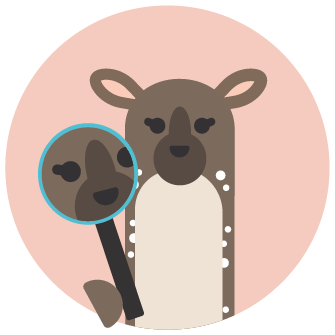Finnish education 🇫🇮 vs. other systems 🏫
Would you like to know how Finnish early education compares to other common philosophies like Montessori and Reggio Emilia? And how does it differ from more traditional western learning methodology? Below we explain the main differences and similarities.

Montessori
Both take a child-focused approach, but Montessori highlights individual learning.

Reggio Emilia
Both value the inquiry-based approach, but Reggio Emilia has less guidelines.

IB Primary Years Program
Both acknowledge the central role of the learner and value trans-disciplinary learning.

Traditional Early Education
Pen and paper versus play, academic focus versus holistic approach and more.

Montessori
There are many similarities between Finnish early education and Montessori:
1. Children and childhood are valued: Montessori philosophy preaches to 'follow the child' and Finnish educators take the child's perspective while they teach. Both approaches value childhood as a special period in life for exploration and discovery.
2. Based on developmental changes: Both systems are grounded in the science of children's learning and development. They do not push children to learn too much too soon and the learning environment welcomes different approaches to learning.
3. Focus on children's strengths: Montessori and Finnish pedagogy emphasize what children do well and build upon those strengths to further their learning and boost their self-confidence.
There are also some significant differences:
1. Learning environment:
In a Montessori school, children learn in a "prepared environment". Materials are intentionally sensory and each toy is designed to accomplish a certain goal within a curriculum area. Built into the design is a control of error, helping children to recognize when they have done something "incorrectly".
In the Finnish approach learning is not limited to the classroom but take place everywhere and all the time. With open-ended learning materials children are welcome to use their creativity. Another important aspect is spending time outdoors and the emphasis of learning through spending time in nature.
Read more in details about this in our blog post.
2. Daily life at school:
Montessori uses work cycles where children work in three-hour work cycles to get absorbed in an activity. Children typically play alone and they take turns to use toys. Children learn autonomy by facing challenging situations alone, which can be difficult for a child with special needs.
Finnish pedagogy emphasizes group learning and during daily activities like morning circle, children sit down and discuss the day together. Children establish common rules for the group and work together to accomplish goals. A day at a Finnish school always includes time for free play, which is an integral part of the learning process.
3. The way teachers interact with children is also different: in the Finnish model teacher provide much more hands-on pedagogical support and guidance in the learning space than teachers at Montessori centers would. Finnish teachers act as facilitators and they give individual support to children who need it.
Reggio Emilia
Finnish early education model has many similarities with the Reggio-Emilia approach: both systems emphasize the importance of a child's own curiosity as motivation to learn and the belief that children have the ability to develop their own potential. Children are seen through their strengths and as active participants of the community.
The Reggio Emilia approach does not have a predetermined curriculum; teachers observe, listen and interpret children’s interest and based on these, facilitate long- and short-term projects for the children. Learning happens through hands-on play-based activities where teachers and children learn alongside each other.
In the Finnish approach children’s interests, needs and developmental phases are also taken into consideration when planning the action. Unlike the Reggio Emilia approach, the Finnish approach follows a nationwide Finnish National Core Curriculum. This way the quality of the education is not defined by the individual teachers and every child has the same rights and access to quality education nationally. In the Finnish system, teachers are trained to observe and utilize children’s own interest in the learning process and to modify the activities in order to fully promote the curiosity and intrinsic motivation born from it.


IB Primary Years Program
The Finnish approach aligns closely with the IB Primary Years Programme, which promotes play, discovery and exploration during the early years. The Finnish national core curriculum focuses on: ‘the active learner’, ‘sustainable living’, ‘integrative teaching’, ‘the school as a learning community’ and ‘comprehensive education’. The IB Primary Years Programme, on the other hand, defines three pillars of school life; ‘the learner’, ‘learning and teaching’ and ‘the learning community’.
Both the Finnish national core curriculum and the IB programmes acknowledge the central role of the learner. The Finnish curriculum states that a student can be supported to make an impact in the community and ultimately global level. The role of the teacher is to guide and to support. There is a clear emphasis on co-teaching and planning, and inquiry based learning.
Phenomenon-based learning, or transdisciplinary learning, refers to making meaningful connections between school disciplines and forms an integral part of the Finnish national core curriculum. The IB Primary Years Programme is an inquiry-based, transdisciplinary, framework and enables students to learn “between, across and beyond traditional subject boundaries.” The IB programme supports facilitating phenomenon-based learning through a carefully constructed Programme of Inquiry.
Traditional approaches
Learning through play versus pen and paper
The Finnish early education model is built on playful learning that is natural to children. Children love to play and they have a great imagination and hence playful learning feels very natural to them. Think of yourself when doing something you like, it feels enjoyable, not laboursome.
Often people think that playing and learning somehow contradict each other. On the contrary, playing enhances learning and increases a child's motivation to learn. In the Finnish system, a child learns the same academic skills as they learn in the more traditional settings, only the methods are different.
Holistic view of development versus solely focusing on academics
The Finnish system uses an assessment system that looks at the whole child, not only the academic skills they are learning. The Finnish assessment system includes topics like play and socio-emotional development together with more academic skills like cognitive development.
Emphasizing socio-emotional learning
In the Finnish curriculum, socio-emotional skills are present starting from the learning objectives children have. In the Finnish early education setting, children are always working as members of a group versus individually and this aspect helps them practice their socio-emotional skills greatly. In those educational settings where children work more independently socio-emotional skills may not get as much practice as in the Finnish setting. Also, a very formal education setting (e.g. sitting quietly and following instructions) gives children a lot less possibilities to practice their socio-emotional skills.


